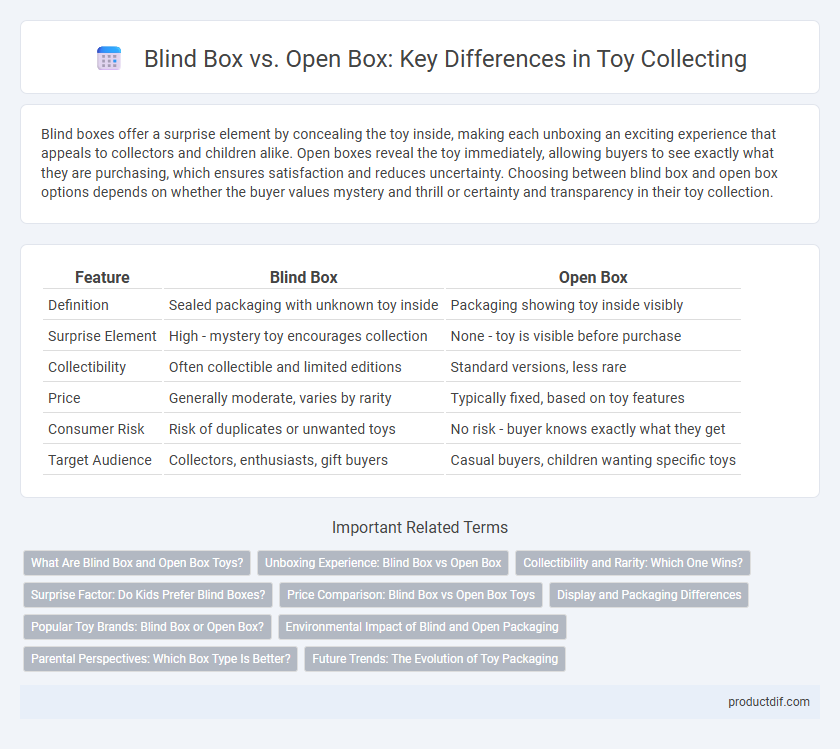Blind boxes offer a surprise element by concealing the toy inside, making each unboxing an exciting experience that appeals to collectors and children alike. Open boxes reveal the toy immediately, allowing buyers to see exactly what they are purchasing, which ensures satisfaction and reduces uncertainty. Choosing between blind box and open box options depends on whether the buyer values mystery and thrill or certainty and transparency in their toy collection.
Table of Comparison
| Feature | Blind Box | Open Box |
|---|---|---|
| Definition | Sealed packaging with unknown toy inside | Packaging showing toy inside visibly |
| Surprise Element | High - mystery toy encourages collection | None - toy is visible before purchase |
| Collectibility | Often collectible and limited editions | Standard versions, less rare |
| Price | Generally moderate, varies by rarity | Typically fixed, based on toy features |
| Consumer Risk | Risk of duplicates or unwanted toys | No risk - buyer knows exactly what they get |
| Target Audience | Collectors, enthusiasts, gift buyers | Casual buyers, children wanting specific toys |
What Are Blind Box and Open Box Toys?
Blind box toys are collectible items sold in sealed packaging, concealing the specific figure inside to create an element of surprise and rarity. Open box toys allow buyers to see the exact product before purchase, ensuring selection of preferred characters or models without uncertainty. Both formats attract collectors, but blind boxes emphasize chance and exclusive limited editions.
Unboxing Experience: Blind Box vs Open Box
Blind box toys create a suspenseful unboxing experience by concealing the item inside, enhancing excitement and surprise for collectors. Open box toys offer immediate gratification by displaying the product clearly, allowing buyers to know exactly what they are purchasing. The choice between blind box and open box impacts consumer engagement, with blind boxes appealing to thrill-seekers and open boxes favoring certainty and transparency.
Collectibility and Rarity: Which One Wins?
Blind boxes create an element of surprise that greatly enhances collectibility by offering rare and limited-edition figures that appeal to avid collectors. Open box toys provide immediate access to the desired item, but lack the scarcity-driven excitement that blind boxes generate, often reducing their collectible value. The rarity of blind box items typically outshines open box counterparts, making them the preferred choice for those seeking unique and highly sought-after collectibles.
Surprise Factor: Do Kids Prefer Blind Boxes?
Blind boxes create a stronger surprise factor by hiding the toy inside sealed packaging, making the unboxing experience exciting and unpredictable for kids. This element of mystery often increases anticipation and engagement compared to open boxes, where the toy is visible before purchase. Many children prefer blind boxes because the thrill of discovering a rare or favorite character enhances playtime and collectible value.
Price Comparison: Blind Box vs Open Box Toys
Blind box toys typically cost more per unit due to the element of surprise and limited edition exclusivity, driving demand among collectors. Open box toys often have a lower price as buyers can assess the product beforehand, reducing the risk and eliminating the mystery factor. Market trends show blind box prices can increase further in secondary markets, whereas open box toys maintain more stable pricing.
Display and Packaging Differences
Blind boxes feature sealed packaging that conceals the toy, enhancing surprise and collectible appeal, while open boxes allow immediate viewing and inspection of the toy. The display potential of blind box toys often relies on the exterior artwork and branding, whereas open box toys can be showcased directly, highlighting detailed craftsmanship. Packaging for blind boxes is typically compact and uniform, designed for stacking and retail presentation, contrasting with open box packaging that prioritizes visibility and accessibility.
Popular Toy Brands: Blind Box or Open Box?
Popular toy brands like Funko, LEGO, and Kidrobot excel in the blind box market by offering collectible surprises that enhance excitement and rarity. Open box toys from brands such as Hasbro and Mattel provide consumers with immediate visibility and assurance of quality and content. Both blind box and open box formats appeal to different collector preferences, influencing purchasing behavior in the toy industry.
Environmental Impact of Blind and Open Packaging
Blind boxes generate more environmental waste due to increased packaging materials and collectible-exclusive designs, leading to higher carbon emissions in production and disposal. Open box toys often use less complex packaging, reducing plastic and cardboard consumption and enabling easier recycling. Choosing open packaging supports sustainable consumer habits by minimizing resource use and promoting eco-friendly recycling systems.
Parental Perspectives: Which Box Type Is Better?
Parents often prefer open boxes over blind boxes due to the transparency they offer, allowing children to see the toy before purchase and reducing the risk of disappointment. Blind boxes, while exciting for surprise and collectibility, can lead to repeated purchases and increased spending, which some parents view as less cost-effective. From a parental perspective, open boxes encourage informed buying decisions and minimize frustration, supporting more controlled and satisfying play experiences.
Future Trends: The Evolution of Toy Packaging
The future of toy packaging is shifting towards interactive blind boxes that enhance surprise and collectability, supported by digital integration like augmented reality experiences. Open box packaging remains relevant for display and immediate play, but evolving consumer demand for novelty encourages brands to innovate with eco-friendly and customizable blind box designs. Sustainability and personalization will drive the evolution, merging tradition with technology to redefine how children and collectors engage with toys.
Blind box vs Open box Infographic

 productdif.com
productdif.com